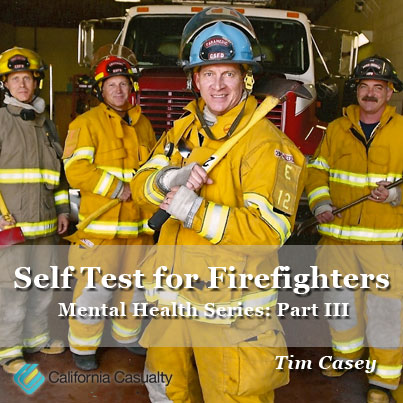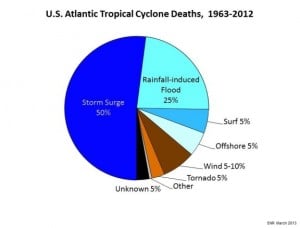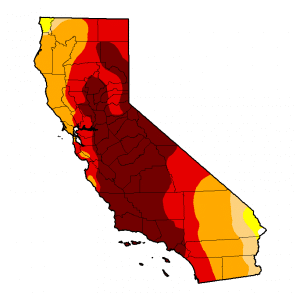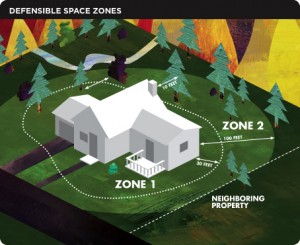by California Casualty | Firefighters |
 Tim Casey describes himself as, “a retired firefighter/paramedic, author, lecturer, public speaker and an alcoholic. As a public servant for more than 30 years, I know the hero business from the inside out, and I also know the costs of that profession; the human cost. My passion is trying to help save the lives of lifesavers. Firefighters are dying in record numbers, not on the job but by their own hands. Clinicians and therapists, although well intentioned, do not know how to help emergency workers and I want to help them understand us, and maybe save some lives along the way.
Tim Casey describes himself as, “a retired firefighter/paramedic, author, lecturer, public speaker and an alcoholic. As a public servant for more than 30 years, I know the hero business from the inside out, and I also know the costs of that profession; the human cost. My passion is trying to help save the lives of lifesavers. Firefighters are dying in record numbers, not on the job but by their own hands. Clinicians and therapists, although well intentioned, do not know how to help emergency workers and I want to help them understand us, and maybe save some lives along the way.
Chief Jeff Dill of the Palatine Rural Fire Protection District in suburban Chicago is a friend of mine and endless source of hope and dedication. I have lectured with him at firefighter conventions.
Because Dill is a nationally recognized authority on behavioral health issues within the fire service. He established Counseling Services for Fire Fighters, LLC based on the tragic events that surrounded Hurricane Katrina. When speaking with firefighters who returned after serving the community of New Orleans, Jeff heard the pleas of firefighters who had a difficult time talking with counselors who did not have any firefighting experience. They became frustrated and never did seek the help they needed. The Firefighter Behavioral Health Alliance (FBHA) 501(c) (3) organization was established to directly educate firefighters/ Emergency Medical Services (EMS) personnel and their families about behavioral health issues such as depression, Post Traumatic Stress Disorder (PTSD), anxiety and addictions, as well as firefighter suicides.
FBHA’s sole goal is to promote good mental health to the men and women of the fire service/EMS and their families; making a significant difference in reducing the numbers of firefighters who are turning to suicide to ease their pain. FBHA Founder Jeff Dill holds a Master’s Degree in Counseling and is a Licensed Professional Counselor in the state of Illinois.
What an amazing and passionate man. Chief Dill has spent countless hours helping fire departments all over America in dealing with firefighter suicide and comforting the families of those left behind.
Here are two dirty secrets of our storied institution, the fire service. When one of us suicides, the event is treated like an off the job incident; in my opinion it rarely is, it is a line of duty death to me, but that isn’t how we treat it.
Second, the families of these brothers and sisters, yeah women firefighters kill themselves too, are treated differently than a firefighter that dies an “honorable” death. They may get short-term support from their department, but they and the memory of their father, husband, wife, sister, or brother are quickly forgotten.
We don’t like to talk about this fact of our way of life; it’s scary to think about, so we step away quickly so we don’t have to think about it.
Chief Dill invited me to speak about my experience as a suicide survivor and firefighter. After I had shared my story with an, unfortunately, tiny audience, a Chief asked me if there was anything any of my co-workers could have done back then.
My answer was a solid yes! My crew knew I was suffering; they knew I was “off” my game; I displayed all the characteristics of someone on the brink. However, here is the thing; I know if one of them had pressed me, asked how I was doing I would have cracked.
Now I’m not putting any blame on anyone other than myself. It isn’t his or her fault I tried to kill myself. What I am saying is if we are the brave souls we fancy ourselves to be, shouldn’t we be brave enough to risk asking these questions of our co-workers and ourselves? Shouldn’t one of the lives we try to be one of our own? I know I questioned patients hard when they seemed to be a risk to themselves, hell I put hundreds on medical holds.
I refused to ask the hard questions of brothers and sisters I suspected of being in danger. It would have been impolite to ask. As I waited to speak with Chief Dill, I tried to work the crowd on his behalf, trying to stir up some interest and get a good crowd to come listen to Chief Dill. Well wasn’t I surprised? There were two major reactions, one was to be polite, take my information, and then quickly toss it in the trash. The other one shocked me.
While relaxing outside I struck up a conversation with two Chiefs from California. I offered them our handout on the warning signs of an impending suicide. They both read it, then one looked at the other and in unison, they said the name of a firefighter and both laughed a bit.
I asked them, “So you both agree you have a guy with these warning signs?” Both answered yes without hesitation. Then I asked what they planned to do about that. They sat there tongue tied with their eyes blinking. “Well, we gotta get inside we’re teaching a class. Thanks for the information.” And with that they walked away.
Ask the hard questions and you may save a brother or sister, or maybe yourself.
This self-test is from Chief Dill’s website. Below is a self-screening for suicide ideations for firefighters. Please circle either Y= Yes or N=No. When you have completed the screening, please review your score at the end.
- Are you feeling like a burden to your family, friends, or Fire Company? Y N
- Do you feel the world would be a better place without you in it? Y N
- Have you started to isolate yourself from others in the firehouse? Y N
- Have you found yourself turning to alcohol or other addictive behaviors to make yourself feel better? Y N
- Have you or someone close to you notice that your sleeping patterns have changed? Y N
- Are you thinking, “What is the use” when going to the fire house or responding on calls? Y N
- Do you find yourself thinking about or performing unnecessary risks while at a fire scene or on an emergency incident? Y N
- Have you found an increased or new interest in risky activities outside the firehouse such as sky-diving, reckless motorcycle riding or purchasing guns? Y N
- Are you displaying unexplained angry emotions or been disciplined recently for anger towards other firefighters? Officers? Or the Public within the last two months? Y N
- Have you been told “you have changed” by Friends? Family? Firefighters? Y N
- Does your family have a history of suicide? Y N
- Do you have a history of feeling depressed? Y N
- Do you have feelings of hopelessness? Y N
- Do you feel like killing yourself? Y N
- Have you created plans to kill yourself? Y N
- 16. Have you recently attempted to kill yourself? Y N
Scoring: Total the amount of (Yes) circled.
Score:__________
If you circled question 15 or 16, then please seek help immediately from a trusted friend, chaplain, counselor, dial 911 or call the National Suicide Prevention Lifeline 1-800-273-TALK (8255) or 1-800-SUICIDE (1-800-784-2433
You can listen to Jeff’s last appearance on the Firefighter Netcast Show here: “Counseling For a Firefighter- By a Firefighter” In this program, Chief Dill tells us about a new resource coming to the aid of the fire service.
by California Casualty | Homeowners Insurance Info |
 Hurricane season began June 1. Are you ready? The nation’s top emergency managers warn that millions of Americans from the Gulf Coast to the Eastern Seaboard as far north as Maine are in danger. Southern California has even experienced tropical storms, giving the West Coast a reason to be concerned.
Hurricane season began June 1. Are you ready? The nation’s top emergency managers warn that millions of Americans from the Gulf Coast to the Eastern Seaboard as far north as Maine are in danger. Southern California has even experienced tropical storms, giving the West Coast a reason to be concerned.
While hurricanes are associated with extreme winds, the National Hurricane Center warns that storm surge actually causes the most damage and loss of life.  The Federal Emergency Management Agency (FEMA) has developed new maps to show the danger. They also have a list of hurricane preparedness tips that include:
The Federal Emergency Management Agency (FEMA) has developed new maps to show the danger. They also have a list of hurricane preparedness tips that include:
- Prepare an emergency kit
- Have a family evacuation and communications plan
- Install hurricane shutters or stock up on boards 5/8 exterior grade or marine plywood to cover windows and doors
- Install straps or additional clips to roofs to reduce damage
- Have a NOAA Weather Radio
- Be prepared to bring in anything that can be picked up by wind (bicycles, lawn furniture, play equipment, grills, etc.)
- Know how to turn off propane tanks and gas lines
- Keep your car’s gas tank full in case of evacuation
Are you covered if a hurricane strikes? The insurance industry recommends everyone take these steps:
- Learn how you can mitigate damage from wind and flooding associated with hurricanes
- Begin or update your home inventory (knowyourstuff.org)
- Understand your insurance – know whether you have actual cash value or replacement cost coverage, know how much living expenses coverage you have and make sure you have flood insurance (not covered with most home or renters insurance)
- Store copies of your inventory and insurance information in a safe location away from home
- Get an annual insurance review to make sure you have enough coverage for the dwelling and possessions
And here is what to do if there is damage to your property:
- Contact your insurance company as soon as possible
- Secure the property from further damage or theft
- Keep or document receipts and other expenses if you are evacuated or forced to find another place to live because of damage to your home or apartment
- Be wary of unscrupulous contractors following a natural disaster
California Casualty is ready to help before or after the storm. Contact an advisor today for a policy review, to arrange for flood insurance or upgrade coverages at 1.800.800.9410 or visit www.calcas.com. It’s also our policy to call customers in a disaster area to make sure you are okay and help start a claim, and our Claims department is available 24 hours a day, even on holidays if you have an emergency.
Resources for this article:
https://www.ready.gov/hurricanes
https://www.redcross.org/prepare/disaster/hurricane
https://www.fema.gov/national-flood-insurance-program-flood-hazard-mapping
https://www.nhc.noaa.gov/prepare/
https://viewer.zmags.com/publication/698e58a3#/698e58a3/1
This article is furnished by California Casualty, providing auto and home insurance to educators, law enforcement officers, firefighters and nurses. Get a quote at 1.800.800.9410 or www.calcas.com.
by California Casualty | Firefighters, Health |
Few jobs are more stressful on a daily basis than being a firefighter. Not only must you deal with dangerous situations, but you’re also required to stay healthy and fit.
Whether you’re facing hectic hours and demanding duties that leave you tired at the end of the day, or spending long hours doing little but wait for a fire or medical emergency call, it’s essential for you take care of your body so it can keep performing well.
Diet and nutrition

As a firefighter, it’s critical that you pay attention to what you’re putting into your body. Obviously, nutrition directly affects physical performance, and as a first responder it’s vital that you’re always in shape and ready to act.
Here’s some advice for eating right:
- Get plenty of carbs. As someone who regularly engages in strenuous physical activity, it’s necessary for you to load up your body with complex carbohydrate-rich foods (such as fruits, veggies, whole-grain products, and cereals). These items fuel your muscles and enable you to enjoy better overall performance.
- Cut back on sugars. If you have a sweet tooth, that may turn out to be your greatest weakness. That’s because foods that are high in sugar slow you down and zap your energy, which you need when responding to a demanding situation.
- Start with a good breakfast. It’s wise to start off your day with a solid first meal. While breakfast is traditionally regarded as the first meal of the day, this could vary depending on your shift schedule. Whatever you first meal is, make it substantial and give yourself sufficient fuel to cover the duration of your shift.
Exercise and fitness

You might understand the importance of staying physically fit, but you likely lack a ton of spare time to work out. The good news is that it only requires a few minutes each day.
- Try high-intensity. There are generally two schools of thought when it comes to workouts. You should either do long, low-intensity workouts, or quick, high-intensity routines. When you’re restricted by time, the latter is extremely valuable. When you commit to high-intensity workout regimens, you realistically need only 20 to 30 minutes. Even for a firefighter with long shifts, that’s reasonable.
- Find a partner. There’s always power in numbers, and you can benefit substantially by having a workout partner. Ideally, this should be someone whoworks the same shifts and has the same fitness goals as you do. You can work with this individual to develop a detailed plan and stay accountable.
- Master the ten-minute routine. Since you never know what’s coming on any given day, it’s smart to save your energy and be prepared. However, that can result in a lot of wasted time if you aren’t careful. That’s where ten-minute routines come in handy. When you’re hanging around the station, try to perform a quick 10-minute workout every hour. These routines will keep you fit without draining your energy all at one time.
Sleep and relaxation

You mustn’t forget about sleep and relaxation. The only way to prepare yourself properly for your next shift is to take advantage of your down time and refuel.
- Find a schedule. If your shifts are sporadic, it can be challenging to establish any continuity — but a schedule is important. If you find yourself lying in bed without falling asleep, get up, do something, and then return to bed after 20 minutes. Agonizing over sleep will make it more difficult to nod off.
- Watch your diet. Avoid alcohol, caffeine, and excess fluids prior to going to sleep. Having too much in your system will affect your quality of sleep and may cause disruptions through the night.
Auto insurance for firefighters
At California Casualty, we offer superior auto insurance for firefighters. We do this because we believe our local first responders deserve reliable and effective protection, too.
For more information on our various polices, or for answers to your questions, please reach out and contact us today!
by California Casualty | Homeowners Insurance Info |
California is parched, and bracing for another scary fire year. Once again, much needed rain and snow has eluded the state. The snow pack is a paltry six percent of normal and this January through March was the driest ever in recorded history. The U.S. Drought Monitor has much of the Golden State in extreme or exceptional drought.
In many areas the unprecedented drought has reduced the greenery to dried sticks and CAL FIRE is warning that moisture content in fuels like trees and grasses are at extremely low levels – leaving them tinder dry and susceptible to wildfire.

2015 Exceptional Drought-U.S. Drought Monitor
The National Interagency Fire Center is predicting above normal wildland fire potential for much of California, starting in May and June and continuing through fall.
It is imperative that you take steps NOW to protect your home and property.
That’s why California Casualty has prepared this important fire prevention information, because we have a stake in keeping you, your family and your most important asset as safe as possible.
Home Wildfire Prevention Tips:

- Create a 30-foot defensible space around your home by removing as much flammable material as you can. Replace flammable vegetation with fire resistive plants.*
- Reduce the number of trees in heavily wooded areas by spacing native trees and shrubs at least 10 feet apart. On trees taller than 18 feet, prune lower branches six to ten feet off the ground.
- Remove branches overhanging the roof or coming within 10 feet of the chimney. Clean all dead leaves and needles from the roof, gutters, and yard.
- Install a roof that meets a fire classification of “Class B” or better. Cover the chimney outlet and stovepipe with nonflammable screening no larger than half-inch mesh.
- Install dual- or triple-paned windows, and limit the size and number of windows that face large areas of vegetation.
- Put woodpiles and liquid propane gas tanks at least 30 feet from all structures and clear away flammable vegetation within 10 feet of those woodpiles and propane tanks.
*California Casualty has a free “Reducing Wildfire Risk” pamphlet available here. You can also find additional helpful information linked from our home insurance page.
Help Firefighters Save Your Home!
- Make access easy. Roads need to be wide enough to accommodate fire trucks with room for them to turn around. Driveways and bridges must be strong enough to carry heavy emergency vehicles and equipment. Identify at least two ways to and from your house and make sure they are clearly marked. All access routes should be free of low hanging tree branches and cleared of flammable vegetation at least 10 feet from roads and five feet from driveways.
- Maintain an emergency water supply that meets fire department standards, such as a community water hydrant system, or a cooperative emergency storage tank with neighbors. If your water comes from a well, consider an emergency generator to operate the pump during a power failure. Clearly mark all water sources and create easy access to your closest emergency water source.
If You’re Forced to Evacuate:
- Know the best routes to safe areas and practice them with your family.
- Prepare an evacuation kit ahead of time.
- Know where and how you and your family will reconnect if you become separated.
In case of possible evacuation, your kit should contain the following items:
- Social Security cards
- Driver’s licenses
- Credit cards
- House deed
- Copies of vehicle titles
- Marriage license
- Birth certificates
- Copies of insurance policies
- Home inventory list / photos
- Health insurance cards
- Prescription medications
- Baby food or formula (if you have little ones)
- Important personal computer information downloaded to disk
- Valuable jewelry
- Photographs
- Home videos
- Items with sentimental value, such as wedding dress or baby keepsakes
- One week’s worth of clothing
- Pets with ID tags, carriers, and pet food
FEMA has more information about evacuation kit and plans at https://www.ready.gov/build-a-kit
Insurance Tips if You’re Impacted:
- Residents evacuated from their homes should contact their insurance agents or companies immediately and let them know where they can be reached. As adjusters are allowed into the burned-out areas they will want to go in with their policyholders to assess the damage. Many companies will set up 24-hour emergency hotlines.
- Keep receipts. Out of pocket expenses during a mandatory evacuation are reimbursable under most standard homeowner policies.
- Be prepared to give your agent or insurance representative a description of your damage.
- Take photos of the damaged areas. These will help with your claims process and will assist the adjuster in the investigation.
- Prepare a detailed inventory of all damaged or destroyed personal property. Be sure to make two copies-one for yourself and one for the adjuster. Your list should be as complete as possible, including a description of the items, dates of purchase or approximate age, cost at time of purchase and estimated replacement cost.
- Make whatever temporary repairs you can. Cover broken windows, damaged roofs and walls to prevent further destruction. Save receipts for supplies and materials you purchase. Your company will reimburse you for reasonable expenses in making temporary repairs.
- Secure a detailed estimate for permanent repairs to your home from a reliable contractor and give it to the adjuster. The estimate should contain the proposed repairs, repair costs and replacement prices.
- Serious losses will be given priority. If your home has been destroyed or seriously damaged, your agent will do everything possible to assure that you are given priority.
Don’t forget to make a complete inventory of all the items in your home before disaster strikes – doing so will help if you have to make a claim.
Here’s a List of Fire Prevention Resources:
www.calfire.ca.gov/fire-prevention
www.nfpa.org
www.disastersafety.org
https://www.redcross.org/images/MEDIA_CustomProductCatalog/m4340149_Wildfire.pdf
https://www.ready.gov/build-a-kit
https://www.knowyourstuff.org/iii/login.html
A defensible space pamphlet from California Casualty can be found on our resource page, www.calcas.com/resources.
by California Casualty | Firefighters, Health, Peace Officers |
As the first people on the scene during accidents, emergencies, and crimes, first responders are susceptible to experiencing strong emotional and physical reactions to stress. From sadness and fear to anxiety and anger, stressful emotions experienced on the clock are easily taken home at the end of your shift. Without an ongoing commitment to living a healthy, stress-reducing lifestyle, debilitating disorders, like chronic depression and PTSD, can emerge. Whether you’re an EMT, firefighter or police officer it’s important to take proactive measures to protect yourself from the destruction stress can cause.
Stress Management Isn’t Just Important – It’s Urgent!
The combination of mental and physical effects of stress can become unbearable, particularly for first responders who need to remain focused and clear-headed at work. Compared to other professionals, first responders are often last to seek help for work-related stress. According to the International Journal of Emergency Mental Health, first responders experience extreme discrimination from peers, including derogatory remarks, labelling, and loss of social status, when attempting to seek help. To effectively manage stress as a first responder, the first step is to learn about the two basic forms of stress you are likely to experience: stress during an incident and stress after an incident
Underestimating the duration of stress and its effects on mental and physical health is one of the biggest mistakes made by emergency personnel. Before you can begin to manage stress, it’s necessary to understand what stress looks like during and after a traumatic event. Emergency medical professionals, firefighters and police officers experience the following:
- Stress during an incident. Between denial, sorrow, fear, and numbness, many feelings can overwhelm you during an incident. Increased irritability, inability to concentrate, and irrational thoughts, are psychological signs of stress taking hold. Physically, stress may induce rapid heart rate, nausea, and shortness of breath.
- Stress after an incident. After experiencing a traumatic event, many first responders report an inability to sleep well, recurring nightmares, distractibility, and an inability to regulate emotions. Family conflicts, isolation, and chronic mental or physical disorders can occur as a result of unmanaged stress.
Learning to recognize the symptoms and consequences of stress is the first step in stress management. The next step is to learn to reduce stress.
8 Tips to Help First Responders Reduce Stress

Both on and off the job, you have the power of choice. Choose to stay at the top of your game by engaging in these 8 stress-reducing activities:
- Take time off when needed. Regardless of their role, first responders are an exceptional group of individuals committed to helping others and preserving safety. This dedication, while admirable, can quickly lead to a feeling of being overworked and highly stressed. After a particularly traumatic incident on the job, take time off to regroup and reinvest in yourself.
- Find a hobby. Essential for personal development, hobbies are a safe, healthy, and fun way to shift focus away from stressors and toward relaxation. From gardening or playing cards to painting or joining a club, participating in activities outside the workplace adds balance and serenity to your life.
- Exercise regularly. Keep up with the physical demands of your profession while maintaining a healthy weight by exercising regularly. Research indicates that exercise increases the body’s level of endorphins, resulting in improved mood, decreased irritability, and an enhanced ability to concentrate. Choose a fun fitness routine, like boxing or group classes, to remain motivated to exercise.
- Eat healthy foods. Expecting an uninterrupted lunch break as a first responder may seem farfetched, but that isn’t an excuse to load up on carbs, fat, sugar, and salt. In addition to negatively affecting your overall health, consuming unhealthy, processed, or fast foods can lead to increased irritability, low energy, and poor concentration. Instead, drink plenty of water and eat balanced meals that include whole grains, lean protein, and vegetables.
- Practice meditation or yoga. To battle the effects of stress, engage in meditation or stress-relieving exercises, like yoga. By combining stretches, breathing exercises, and bodily poses, yoga helps relieve anxiety, depression, and stress. Meditation alone is shown to help alleviate feelings of anxiety and depression, as well as reduce pain. According to the National Center for Complementary and Alternative Medicine, meditation is a technique used by nearly 10% of adults in the U.S.
- Start a journal. Communicating your thoughts and feelings is crucial to overcoming the experience of trauma. Even if you’re not ready to speak with a counselor, keeping a journal about your experiences allows self-expression without threat of discrimination. Simply writing to yourself will not only help get certain events off your mind, but will also enhance your communication skills.
- Seek counseling. Individual counseling can work wonders for first responders, even if they have not recently experienced trauma. By actively participating in counseling, emergency professionals receive a source of ongoing emotional support while working to manage stress. Working with a therapist to establish and maintain a healthy lifestyle increases your ability to appropriately cope with stress.
- Attend a support group. Participation in social events in a supportive setting is crucial for first responders, as it helps form bonds between those recovering from work-related trauma. Meeting with others who have experienced similar events is both an affirming and reassuring activity. After joining support groups, first responders are able to expand their social networks, focus on healthy relationships, and overcome work-related trauma.
Taking one or more of the above steps will help relieve stress now and in the future. With first responders considered high risk for PTSD and depression, investing in your physical and mental health now is important for ensuring you have an enjoyable future.
The biggest obstacle to getting help is feeling confident when asking for help that the help is confidential. Here is a list of resources. Some are specific to Fire/EMS; some are specific to Law Enforcement. All are resources for confidential help.
American Foundation for Suicide Prevention – Resource for understanding warning signs of suicide and how to get help for yourself or someone else.
Centers for Disease Control and Prevention – Resources for individuals affected by a disaster – including first responders.
National Center for PTSD – Good resource for anyone who has experienced trauma.
National Institute of Mental Health – Good resource for a wide variety of mental health information.
National Suicide Prevention Lifeline – This is a hotline for anyone in crisis or to get help form someone in crisis. You do not need to be suicidal to call this line. They are there to listen and provide resources without judging. Afraid to call? Use the chat function from a computer or mobile device. Either way, you can remain anonymous!
Sites Specific to Fire/EMS:
All Hands Working – Organization dedicated to providing help to firefighters on and off duty.
Firefighter Behavioral Health Alliance – Non-profit organization developed to help educate firefighters and EMS about mental health on the job.
Helping Heroes – List of behavioral health resources specific to firefighters from National Fallen Firefighters Foundation.
Share the Load Support Program for Fire and EMS – Focusing on the mental well-being of firefighters and EMS.
Sites Specific to Law Enforcement:
Badge of Life – Site is specific to law enforcement and suicide prevention.
CopsAlive.com – Information, strategies and tools to help cops plan for happy, healthy and successful careers, relationships and lives.
Tears of a Cop – Site dedicated to stopping officer suicide and providing resources for PTSD.
Asking for help is the hardest thing to do! Sometimes even “heroes” need help. Please reach out if you or someone you know is struggling.
This article is furnished by California Casualty, providing auto and home insurance to educators, law enforcement officers, firefighters and nurses. Get a quote at 1.800.800.9410 or www.calcas.com.
 Tim Casey describes himself as, “a retired firefighter/paramedic, author, lecturer, public speaker and an alcoholic. As a public servant for more than 30 years, I know the hero business from the inside out, and I also know the costs of that profession; the human cost. My passion is trying to help save the lives of lifesavers. Firefighters are dying in record numbers, not on the job but by their own hands. Clinicians and therapists, although well intentioned, do not know how to help emergency workers and I want to help them understand us, and maybe save some lives along the way.
Tim Casey describes himself as, “a retired firefighter/paramedic, author, lecturer, public speaker and an alcoholic. As a public servant for more than 30 years, I know the hero business from the inside out, and I also know the costs of that profession; the human cost. My passion is trying to help save the lives of lifesavers. Firefighters are dying in record numbers, not on the job but by their own hands. Clinicians and therapists, although well intentioned, do not know how to help emergency workers and I want to help them understand us, and maybe save some lives along the way.







